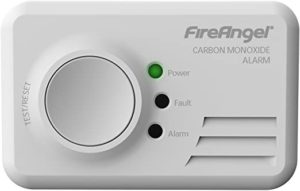
As part of your yearly sweep why not test that CO alarm and smoke alarm, I will always encourage my customers to do so.
The Silent and Invisible Killer. Ken Knight from Knight Security Inc “Carbon monoxide is a highly poisonous gas that has no colour, taste or smell, making it impossible to detect without an alarm.” Carbon monoxide alarms must be audible – they make a loud noise if gas is present. Install one for each fuel-burning appliances within your home – including stoves, fires, boilers and water heaters.
According to Department of Health figures, every year about 40 people in the UK are recorded as having died of carbon monoxide poisoning. A further 4,000 or so attend A & E, Hundreds more suffer ill-effects as a result of exposure to carbon monoxide: sometimes they are permanently disabled. Carbon monoxide can be emitted from faulty domestic heating and cooking appliances. For the latest data see http://www.co-gassafety.co.uk/
We enlisted the help of Kieren O’Brien, a fully licensed gas plumber and director of Lexity. Who advises:-
“Carbon monoxide, you cant see it, smell it or taste it this is why it has been named the silent killer. Carbon monoxide (CO) is a dangerous gas that can be produced in a home from gas appliances and flues that are faulty, incorrectly installed, unmaintained or are inadequately ventilated. Homes are constantly becoming more efficient by reducing the rate air can be exchanged from inside to outside. In addition to becoming more energy efficient homes are having more powerful exhaust fans installed in bathrooms and range hoods in kitchens. The mix of less air entering the property and a stronger suction from exhaust fans can cause what is called a negative pressure within the home between internal and external environments. When a negative pressure is present it can then suck combustion gases including carbon monoxide (CO) back down the flue and in to the home having a deal effect.”
The early symptoms of CO poisoning are usually similar to common ailments such as upset stomach, tiredness and flu. The common symptoms can include:
- Headaches
- Breathlessness
- Nausea and/or vomiting
- Dizziness or Collapse
- Chest and/or stomach pains
- Erratic behaviour and/or Visual problems
Actions to take in a CO emergency
- If you suspect fumes are escaping from your combustion appliance into your home, or your carbon monoxide alarm goes off.
- If your appliance is automatically fed with fuel, turn the appliance off.
- Open doors and windows to ventilate the building.
- Leave the building immediately and don’t return until your appliance or boiler has extinguished and the air in the room is clear.
- If you feel unwell go to your Doctor, call NHS Direct on 111 (where available) or, if it is urgent phone 999 for an ambulance. Tell them you feel your symptoms may be related to carbon monoxide poisoning.
- Before you reuse the appliance, have it serviced by a HETAS Registered Installer and the chimney swept.
- Do not use the appliance until you are told it is safe to do so.
- Have your appliance serviced and cleaned.
- Unblock ventilation
- Ensure your chimney is kept clear by having it swept at frequent intervals
- Make sure the installation complies with Building Regulations guidance. The guidance is there to protect you.
- Fit an audible CO alarm conforming to BS EN 50291:2002 and positioned in accordance with Building Regulations Approved Document J requirements.
Lucinda Curran, Principal Building Biologist and CEO of Eco Health Solutions, advises that you should “have all gas appliances checked annually for faults.” She also adds the following tips:
- Only use gas heaters that are flued and vented to the exterior
- Use the extractor fan when cooking on a gas stove top
- Keep your windows ajar to dilute the indoor air
- Avoid idling the car in the garage or near windows
CO alarms should be regularly tested and should not be regarded as a substitute for regular maintenance of the appliance and chimney.
Or if you have any questions contact ‘The Sweep Guy’

